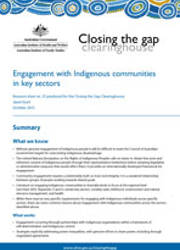Summary
What we know
- Without genuine engagement of Indigenous people it will be difficult to meet the Council of Australian Government targets for overcoming Indigenous disadvantage.
- The United Nations Declaration on the Rights of Indigenous Peoples calls on states to obtain free prior and informed consent of Indigenous people through their representative institutions before adopting legislative or administrative measures that would affect them; it provides an internationally developed framework for engagement.
- Community engagement requires a relationship built on trust and integrity: it is a sustained relationship between groups of people working towards shared goals.
- Literature on engaging Indigenous communities in Australia tends to focus at the regional level (see Hunt 2013, Appendix 1) and in certain key sectors, notably early childhood, environment and natural resource management, and health.
- While there may be very specific requirements for engaging with Indigenous individuals across specific sectors, there are some common lessons about engagement with Indigenous communities across the sectors identified above.
What works
- Engagement occurring through partnerships with Indigenous organisations within a framework of self-determination and Indigenous control.
- Strategies explicitly addressing power inequalities, with genuine efforts to share power, including through negotiated agreements.
- Staff working with Indigenous people who understand the social and cultural context in each place and contemporary social fluidity.
- Sharing responsibility for shared, realistic objectives and collaborative formulation of criteria and indicators for annual self-assessments, including assessment of the processes as well as the outcomes.
- Adequate and sustained resourcing based on the roles and responsibilities of each partner.
- All parties committing to develop long term relationships based on trust, and to work within appropriate timeframes.
- Where land and environmental issues are concerned, planning at the scale of each group’s ‘country’.
What doesn’t work
- Staff operating on assumptions about the Indigenous community, its membership, its governance, and who can represent its views which are not accurate; failing to recognise the diversity within any Indigenous community.
- Staff treating Indigenous people as ‘one stakeholder among many’ rather than as recognised traditional owners of country, especially in environmental work.
- Governments failing to address the power inequalities, expecting Indigenous people to function in western bureaucratic forms and style, and favouring western over Indigenous knowledge.
- Racism embedded in institutions.
What we don’t know
- How ‘mainstream’ organisations could effectively engage Indigenous people without working with and through Indigenous partners.
- There is not a lot of information about effective community engagement in sectors other than those indicated below.
- How well domestic social welfare organisations or many private sector bodies engage Indigenous communities.
Summary
- What we know
- What we don’t know
Introduction
Partnership engagement in early childhood services
Engagement in environment/natural resource management activities
- Where engagement worked
- Where engagement did not work so well
Engagement in health programs
- Where engagement worked
- Where engagement did not work so well
NGO partnerships with Indigenous organisations
Conclusion
Appendix A
End matter: Acknowledgments; Abbreviations; Terminology; Funding; Suggested citation; Copyright



